Why you can trust Tom's Hardware
Comparison Products
With this review we’re trying something a little bit different. Instead of separate pages for each of two drive capacities, we’re looking at both the 1TB and 2TB TN470 simultaneously. Of the alternative drives tested today, that also applies to the WD Black SN850X.
At 1TB, we’re looking at the budget favorite Teamgroup MP44L, the PS5-optimized Seagate Game Drive for PS5, the older and popular Kingston KC3000, and the PCIe 5.0 PNY CS3150. For PCIe 5.0 at 2TB we have the Crucial T705. Also at 2TB we have the budget champion Crucial T500, the high-end PCIe 4.0 Samsung 990 Pro, and the newer Samsung 990 EVO. This helps give a good look at where the TN470 falls at either capacity against common competition, and also helps put PCIe 5.0 drive performance into perspective.
Trace Testing — 3DMark Storage Benchmark
Built for gamers, 3DMark’s Storage Benchmark focuses on real-world gaming performance. Each round in this benchmark stresses storage based on gaming activities including loading games, saving progress, installing game files, and recording gameplay video streams. Future gaming benchmarks will be DirectStorage-inclusive and we include details of that where possible.

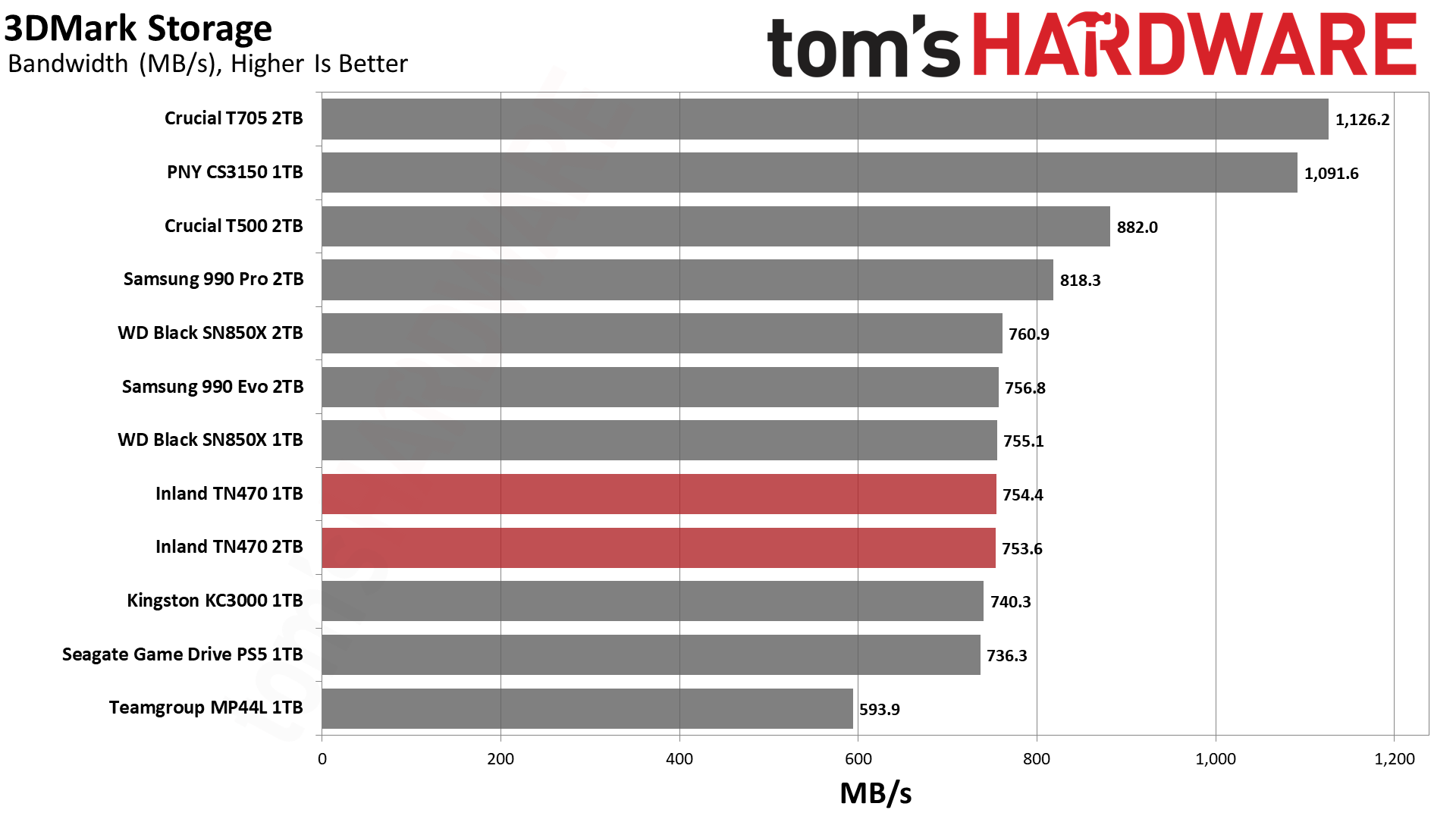
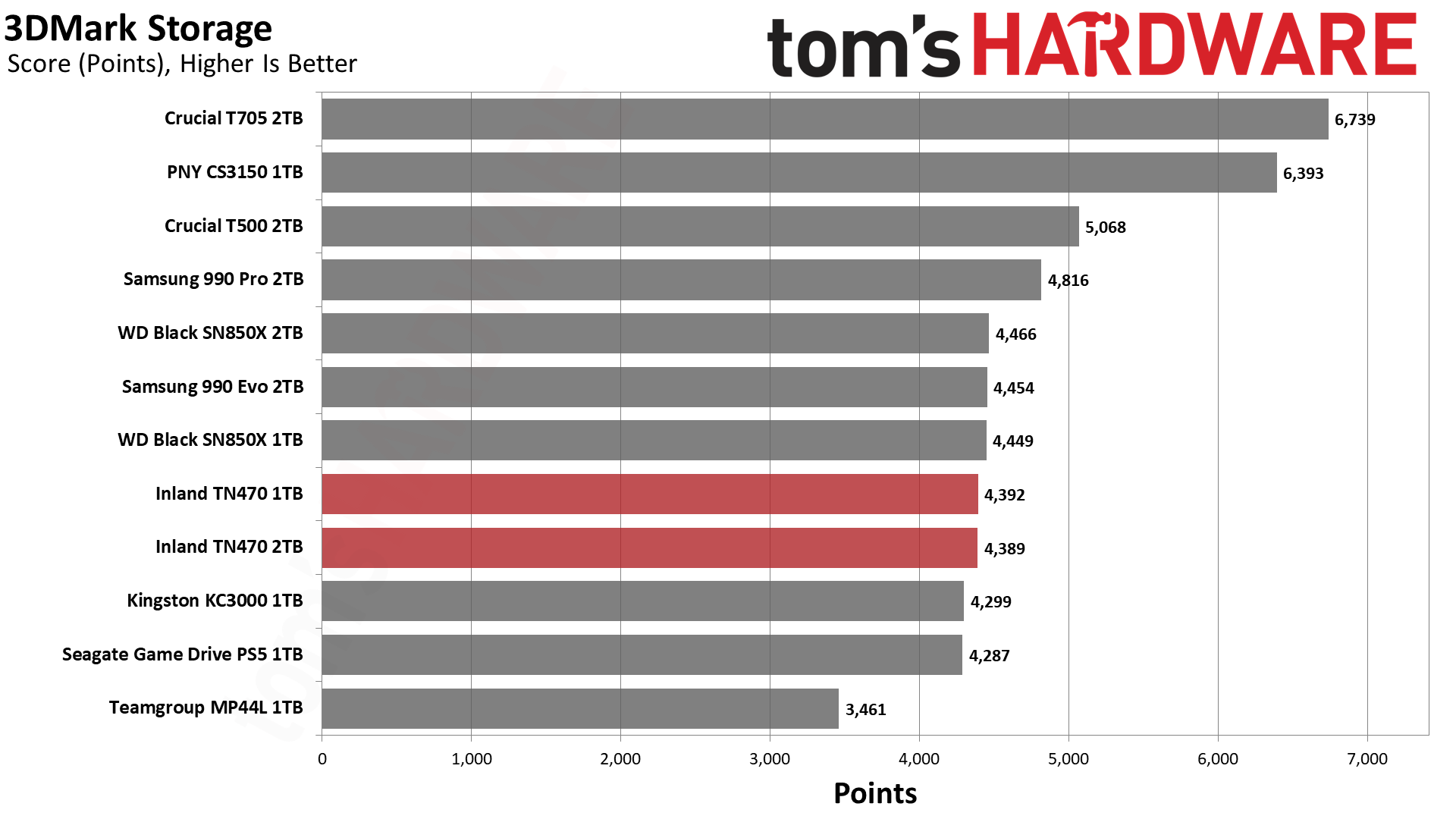
The TN470’s 3DMark performance is good but not amazing. We can say it’s good because it matches high-end PCIe 4.0 drives like the Black SN850X and KC3000. It’s also clearing the MP44L, which uses the slower E21T controller. However, it’s not up to the level of the 990 Pro or the T500 — and naturally can't touch the PCIe 5.0 SSDs. In general we would consider this performance to be excellent, especially for a budget drive. The 1TB and 2TB perform similarly, so nothing is being left on the table.
Another factor to consider is DirectStorage-optimized firmware. Phison touts its I/O+ firmware on its PCIe 5.0 SSDs and it’s also present on the Phison E25-based T500. Some E18-based drives, such as the Sabrent Rocket 4 Plus-G, also have this optimization. It provides performance improvements for workloads that will be used in the future with DirectStorage-enhanced game titles and applications.
So far, games have not used the DirectStorage API for much more than minor loading improvements. Nevertheless, if this is a factor for you in your decision-making process, then it’s worth noting that drives based on Phison’s E21T, like the MP44L, lack this optimization. It seems like Phison wanted to keep this firmware for flagship drives and as a custom feature. However, it seems like it will be bringing it to E27T-based drives like the TN470, according to Inland. This will not be available at launch but adds potential value to these drives over MAP1602-based ones.
What's unclear is whether there will be a firmware update available for the TN470 to enable the feature in the future, or if it will only be offered on newer drives. Inland doesn't normally provide firmware updates that we've seen, and there's no SSD toolbox, so if you buy a TN470 today you shouldn't plan on getting DirectStorage optimizations in the future.
Trace Testing — PCMark 10 Storage Benchmark
PCMark 10 is a trace-based benchmark that uses a wide-ranging set of real-world traces from popular applications and everyday tasks to measure the performance of storage devices.
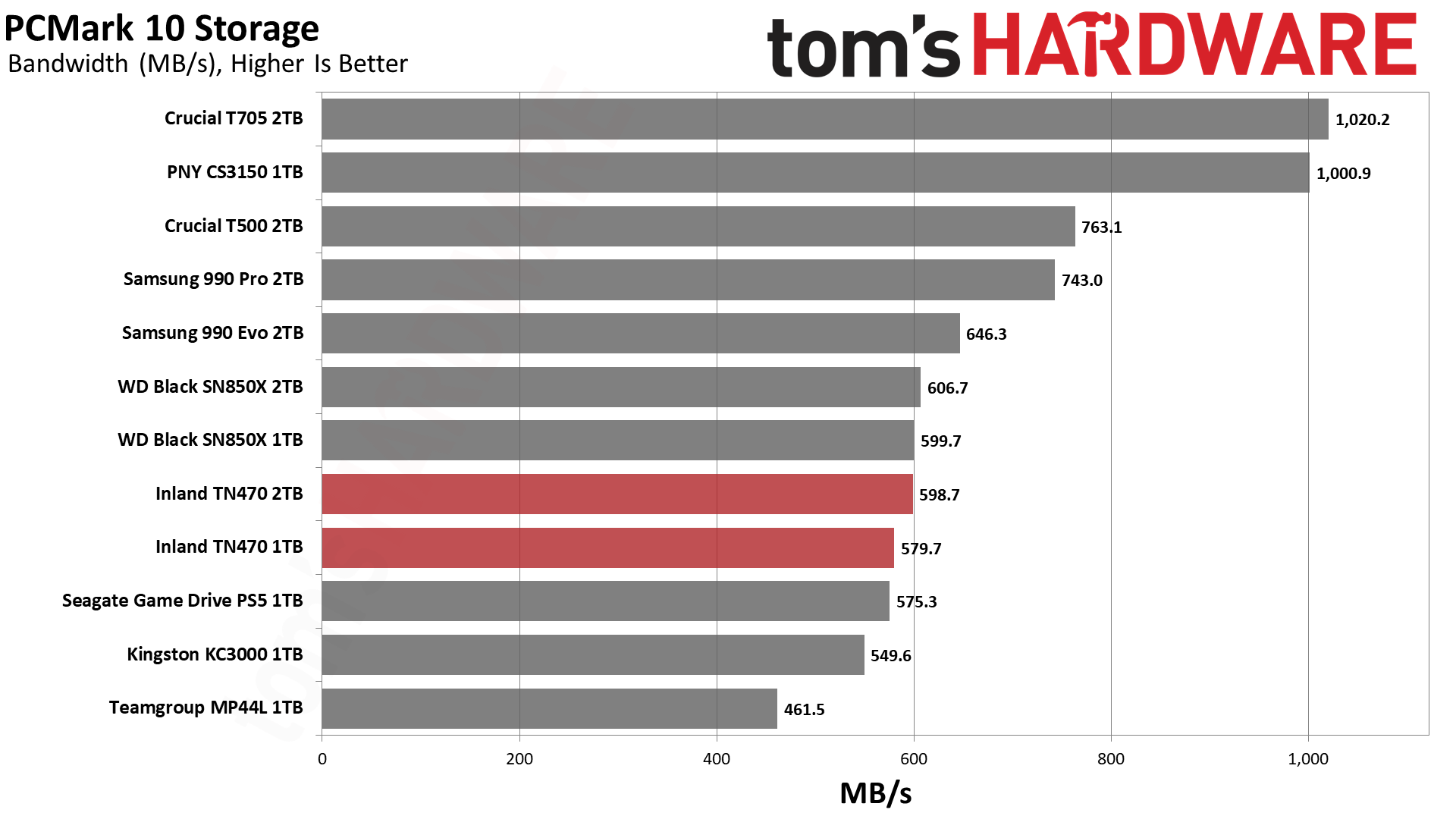
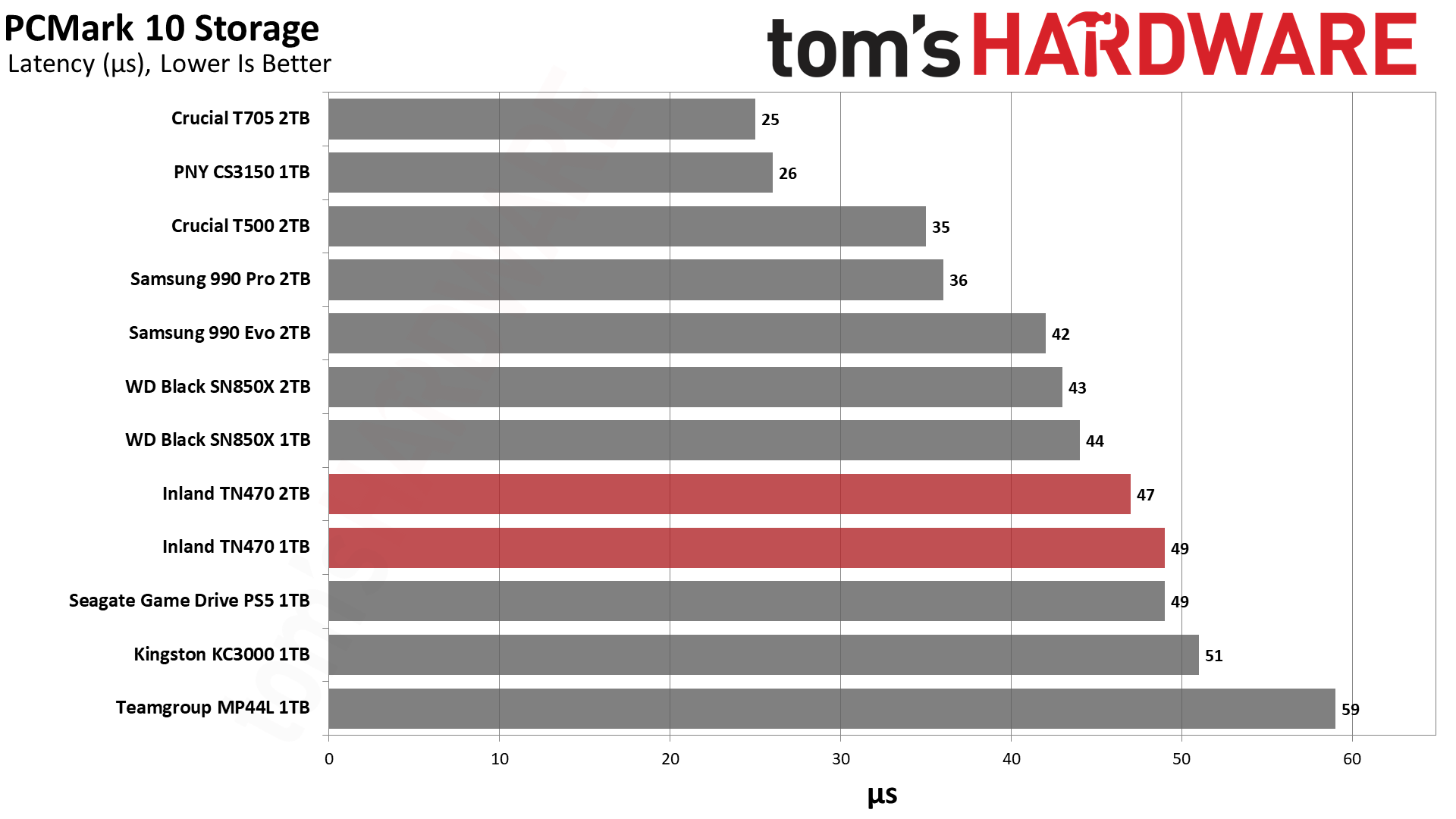

The TN470 performs roughly the same in PCMark 10 as it does in 3DMark, which is typical. The 2TB drive is effectively dead even with the WD SN850X, a very good result. The 1TB is a bit slower, perhaps due to the loss of some bandwidth from less interleaving. Larger SSDs in general can perform better than smaller ones, but there are multiple factors to consider and this performance gap is demonstrated more in some benchmarks than others. In either case, the TN470 performs well for a budget drive.
Console Testing — PlayStation 5 Transfers
The PlayStation 5 is capable of taking one additional PCIe 4.0 or faster SSD for extra game storage, with some requirements. Launch models could not take 8TB drives but this limit has since been removed. While any 4.0 drive will work, Sony specifies drives that can deliver at least 5,500 MB/s of sequential read bandwidth are optimal. The PS5 does not support the host memory buffer (HMB) feature but DRAM-less drives will still work. In our testing, PCIe 5.0 SSDs did not bring much to the table and preferably should not be used in the PS5, especially as they may require additional cooling. Please see our Best PS5 SSDs article for more information.
Our testing utilizes the PS5’s internal storage test and manual read/write tests with over 192GB of data both from and to the internal storage. Throttling is prevented where possible to see how each drive operates under ideal conditions.
Get Tom's Hardware's best news and in-depth reviews, straight to your inbox.

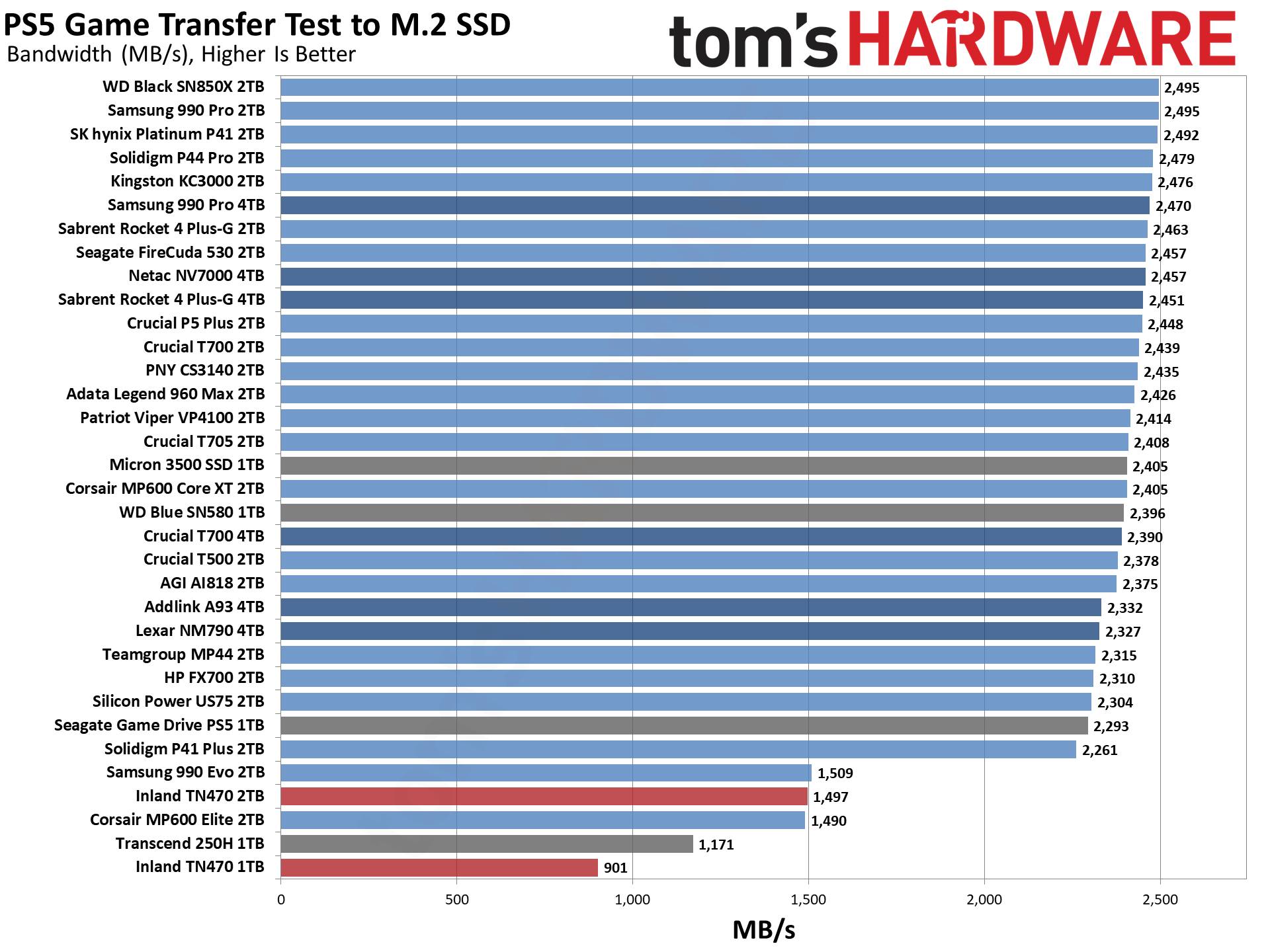

The TN470 hits a bit of a snag in our PS5 testing. While the 2TB drive performs as expected, based on our MP600 Elite results, it generally does not transfer as fast as drives with larger caches. In fact, it’s down near the 990 EVO, which is fairly slow in the transfer test. This isn’t a huge deal, but the 1TB TN470 suffers even more as it has less interleaving. For bigger transfers, this could be an issue. It’s probably better to go for a different drive if you’re only planning to put 1TB into your PS5.
Transfer Rates — DiskBench
We use the DiskBench storage benchmarking tool to test file transfer performance with a custom, 50GB dataset. We write 31,227 files of various types, such as pictures, PDFs, and videos to the test drive, then make a copy of that data to a new folder, and follow up with a reading test of a newly-written 6.5GB zip file. This is a real world type workload that fits into the cache of most drives.
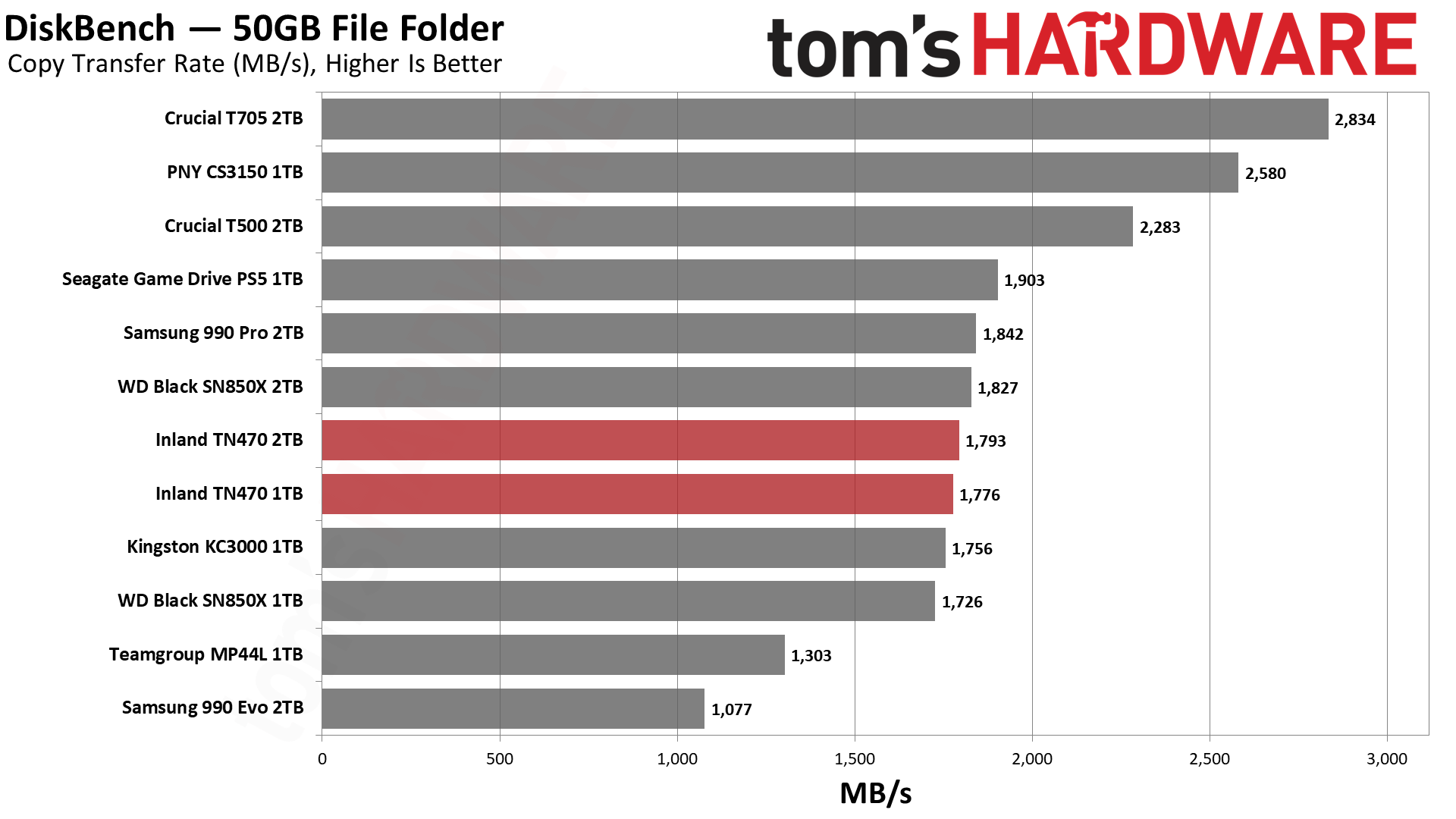
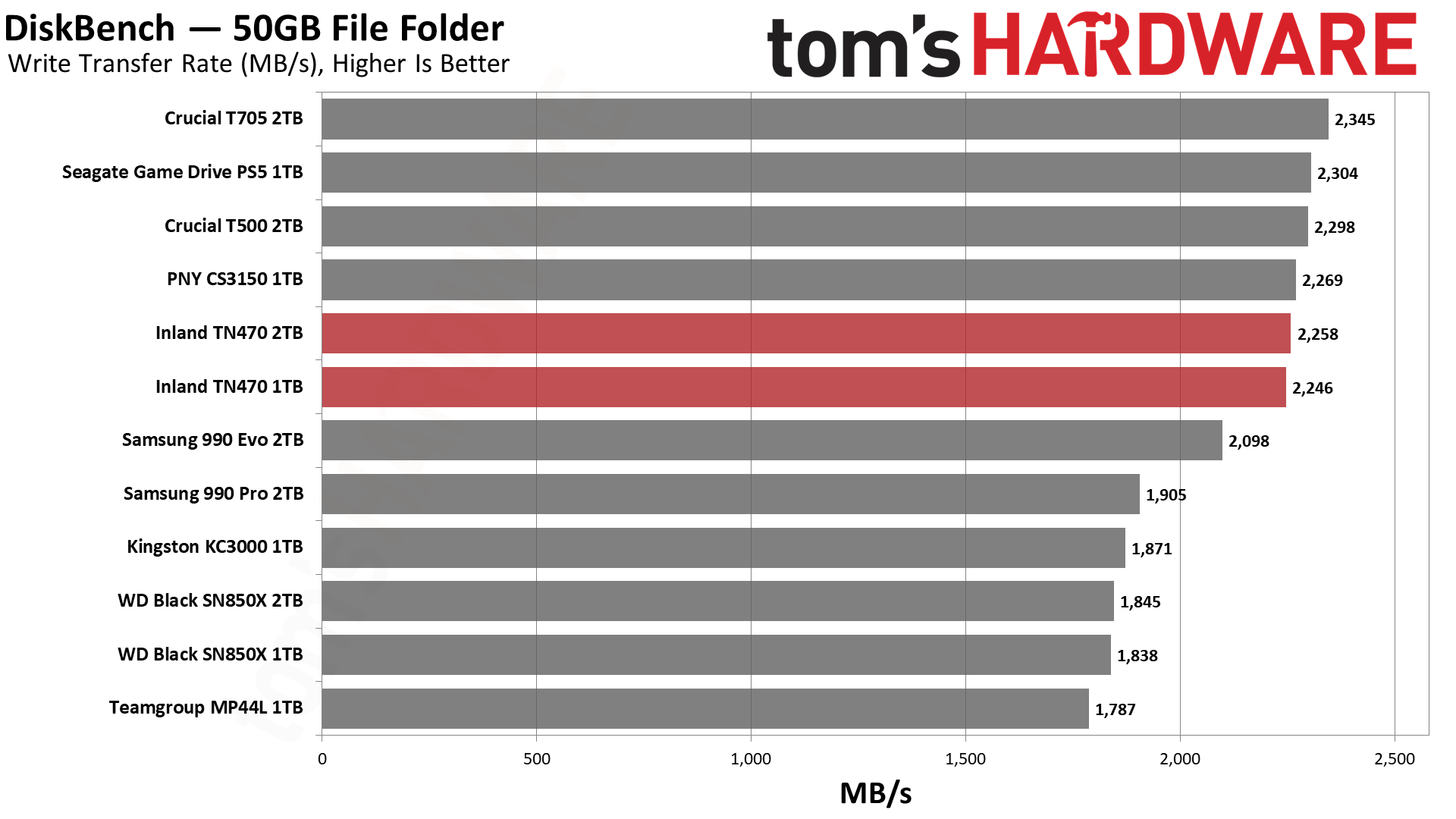
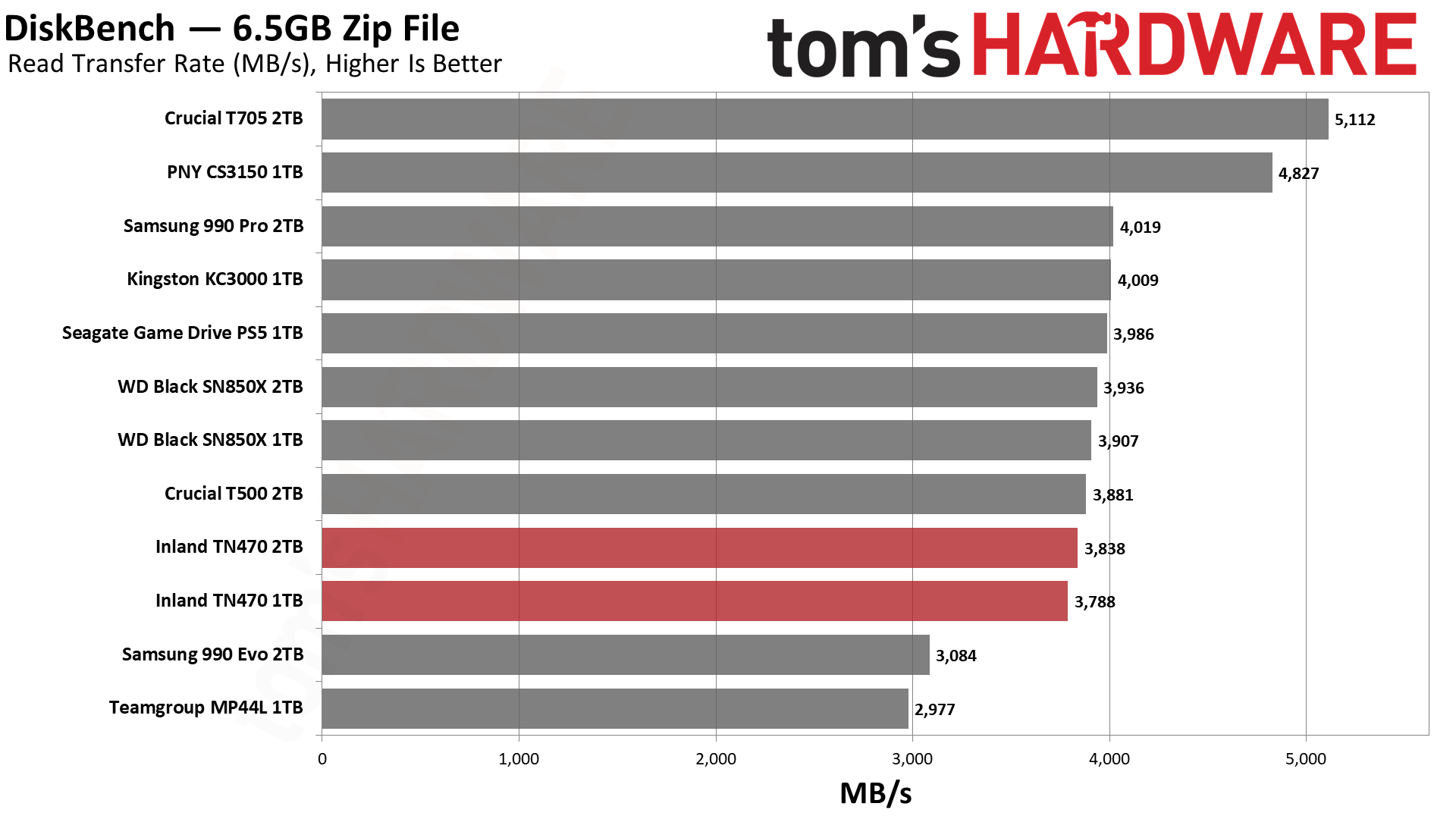
Performance in our DiskBench test, which involves less data than our PS5 test, is better on the TN470 as the data fits in the drive’s cache regardless of capacity. Once again, the TN470 is in the ballpark of fast drives like the SN850X and KC3000.
Synthetic Testing — ATTO / CrystalDiskMark
ATTO and CrystalDiskMark (CDM) are free and easy-to-use storage benchmarking tools that SSD vendors commonly use to assign performance specifications to their products. Both of these tools give us insight into how each device handles different file sizes and at different queue depths.
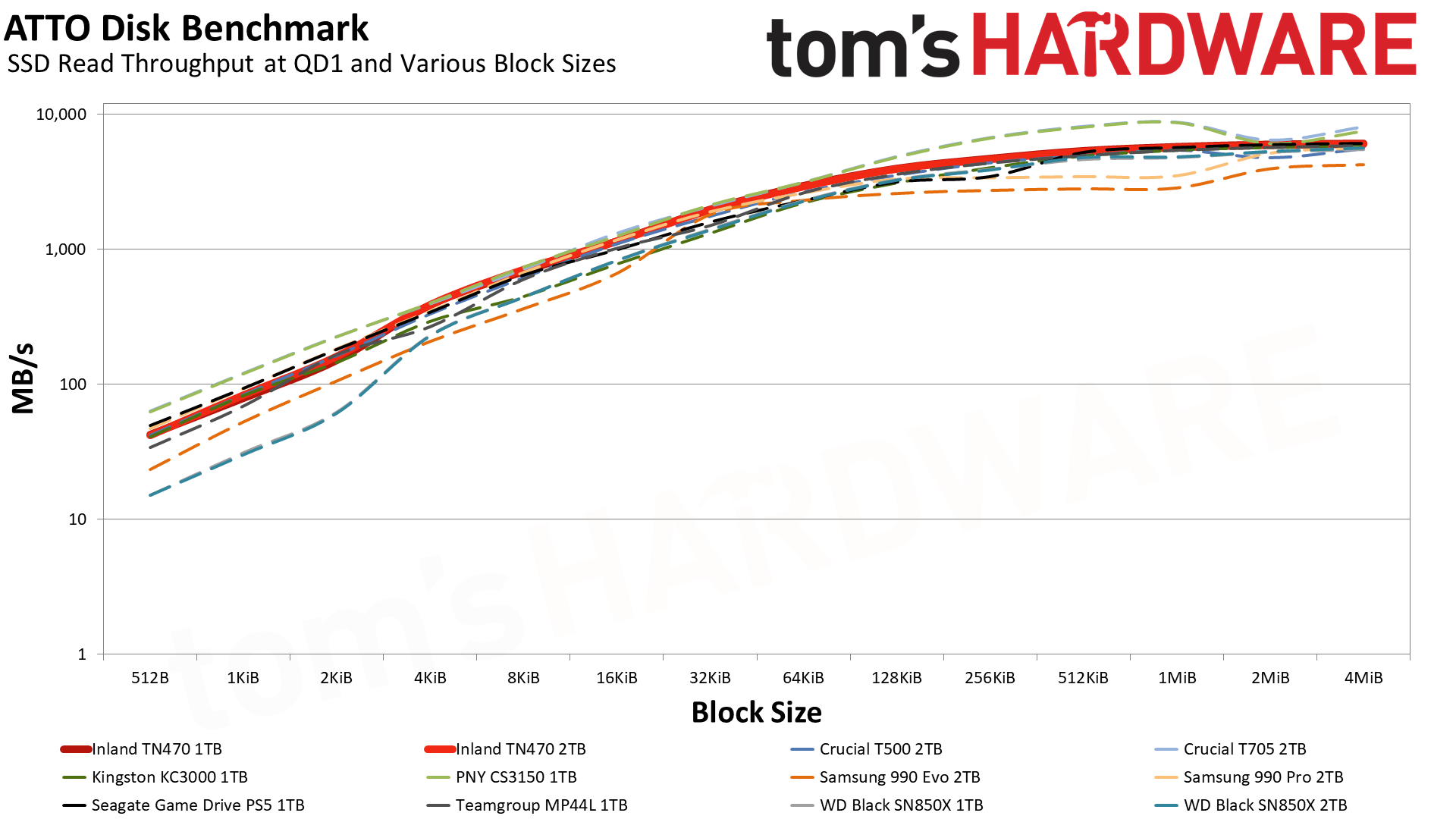
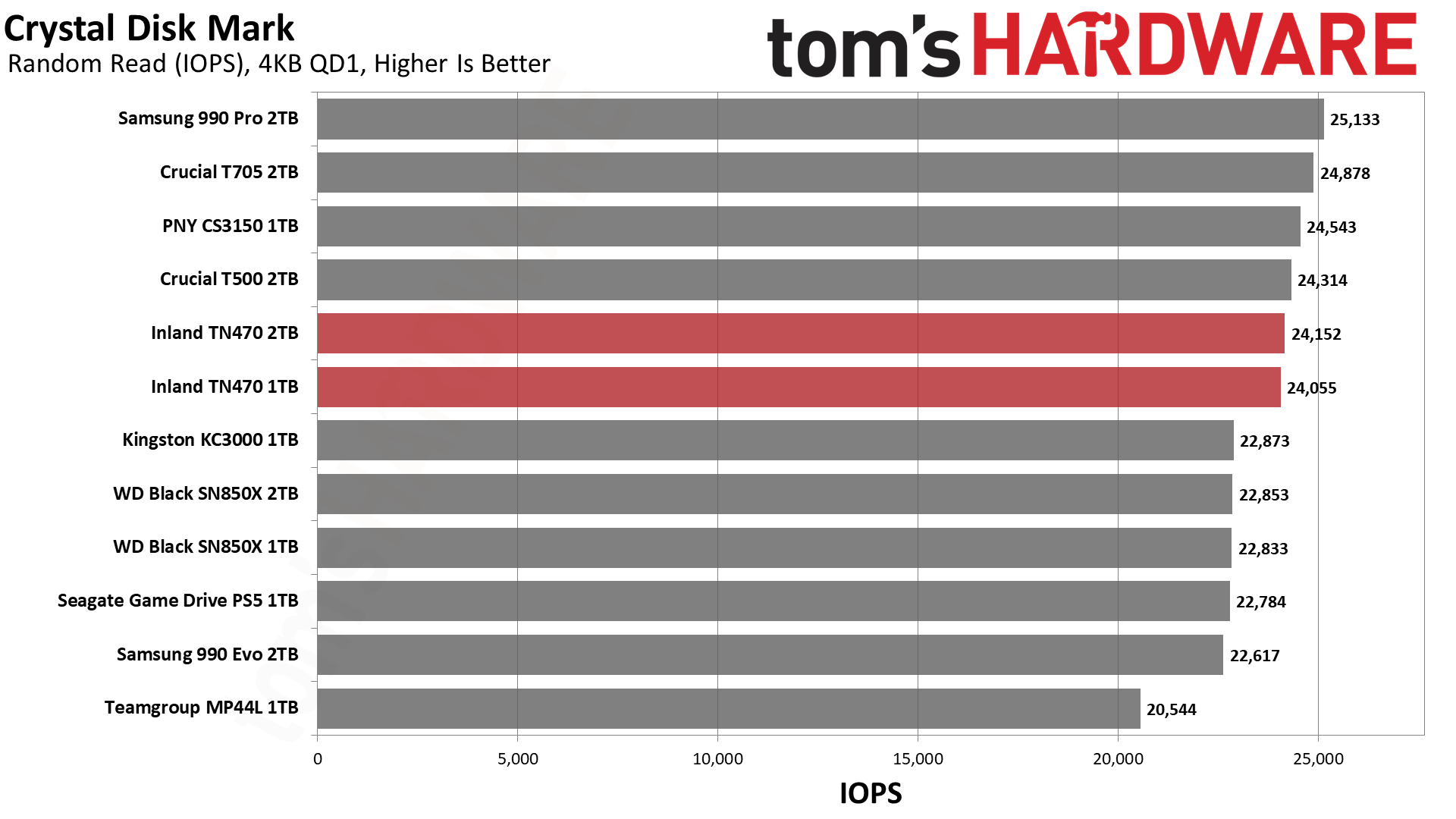

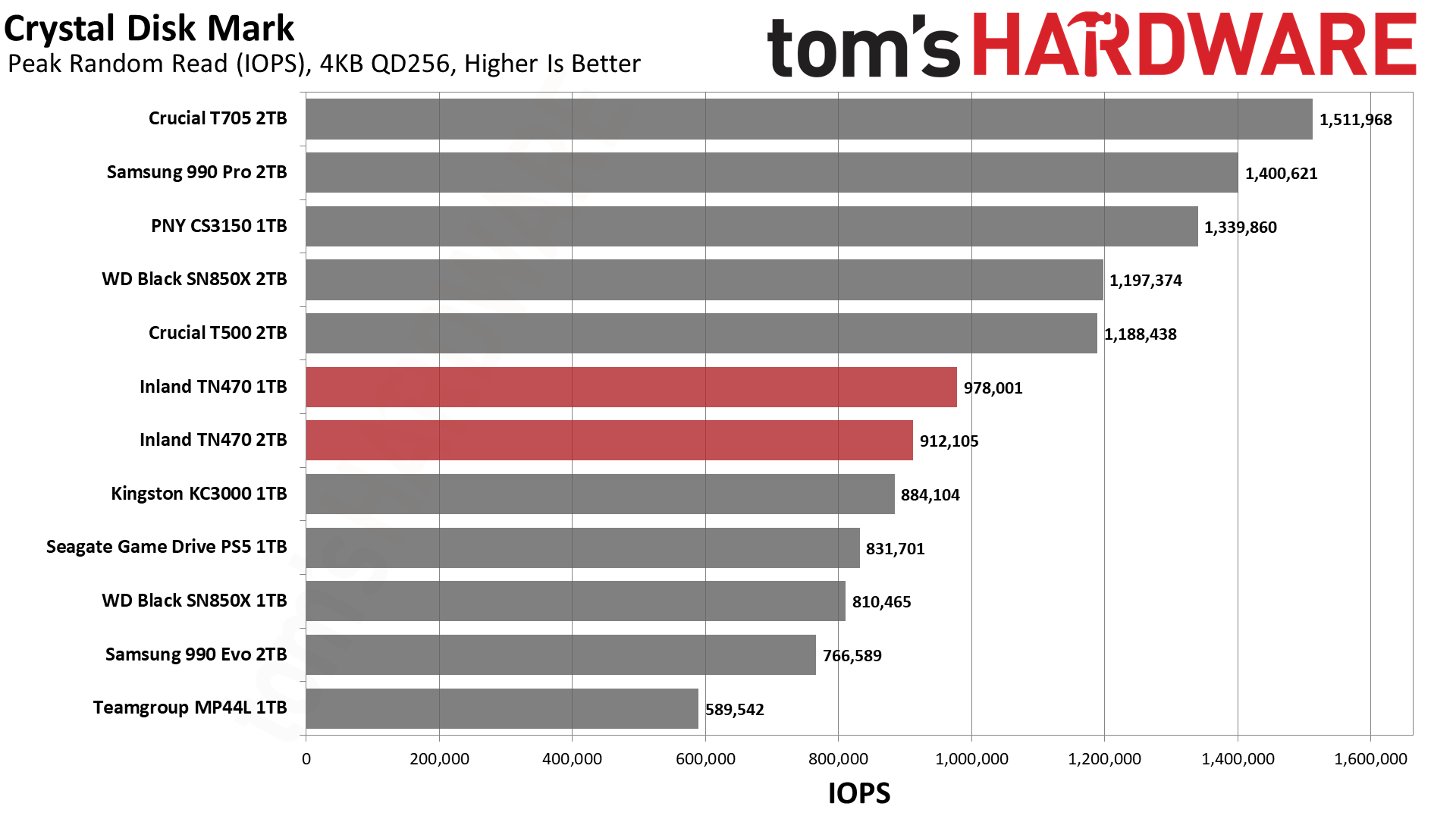

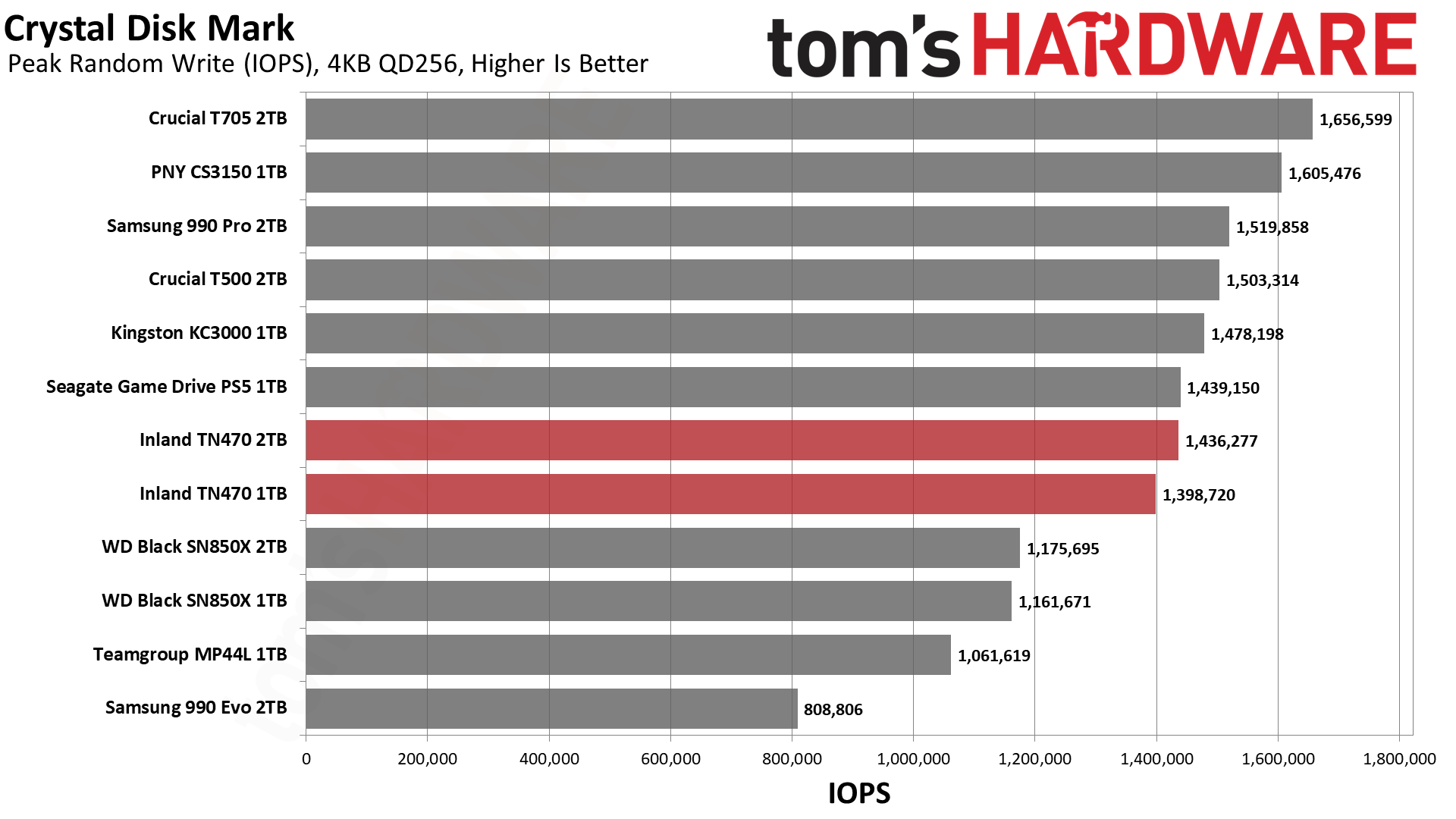
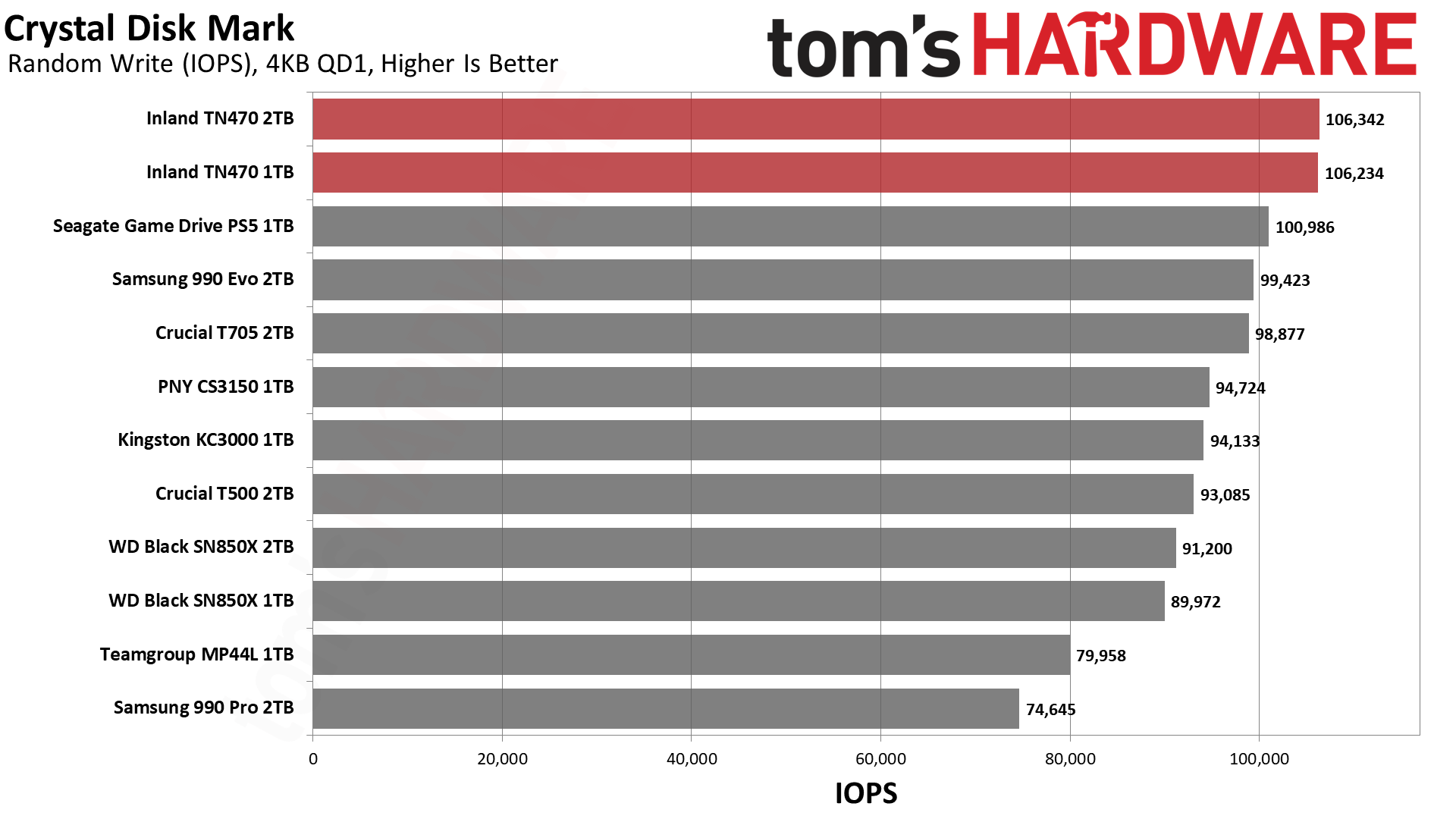
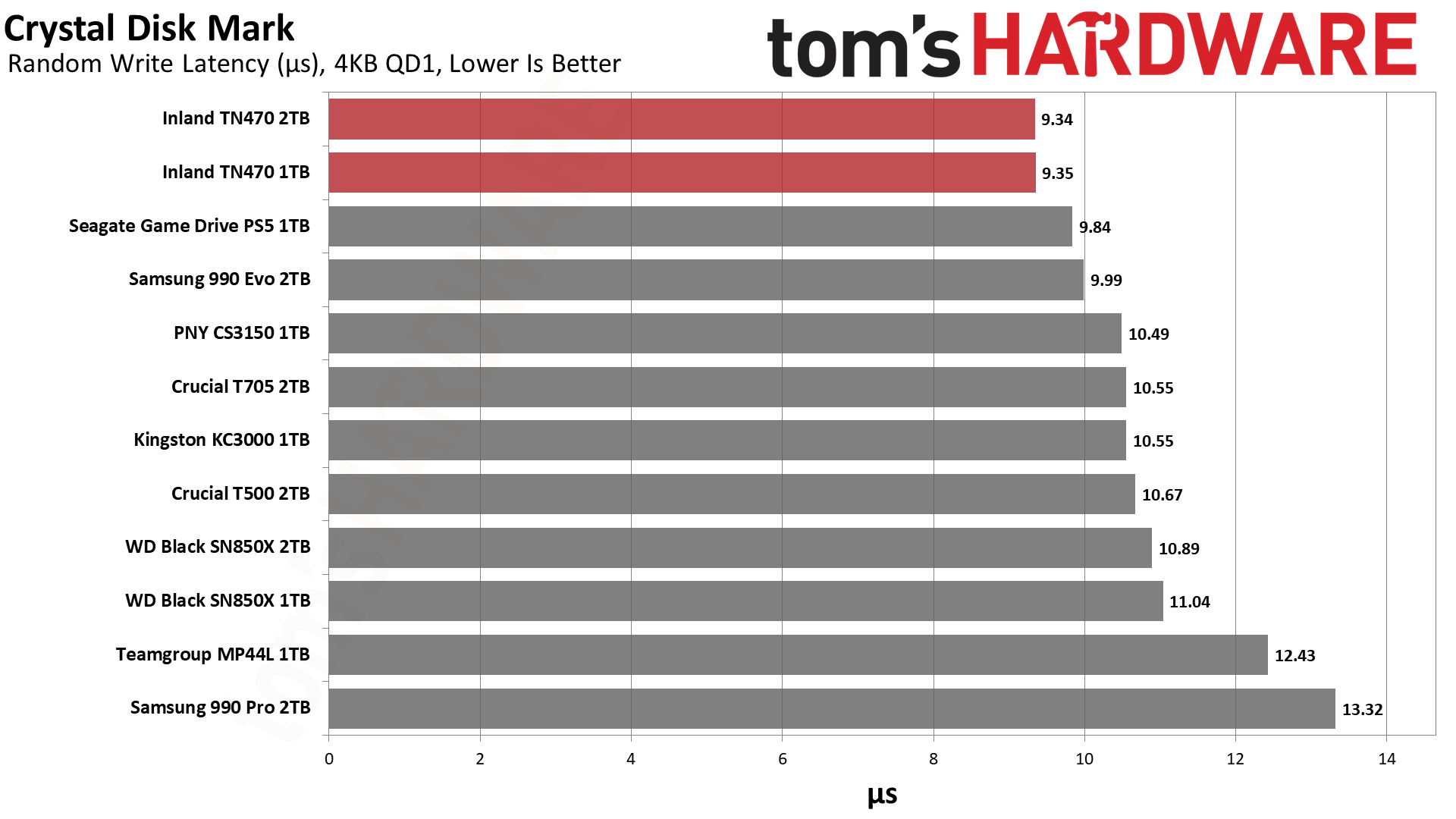
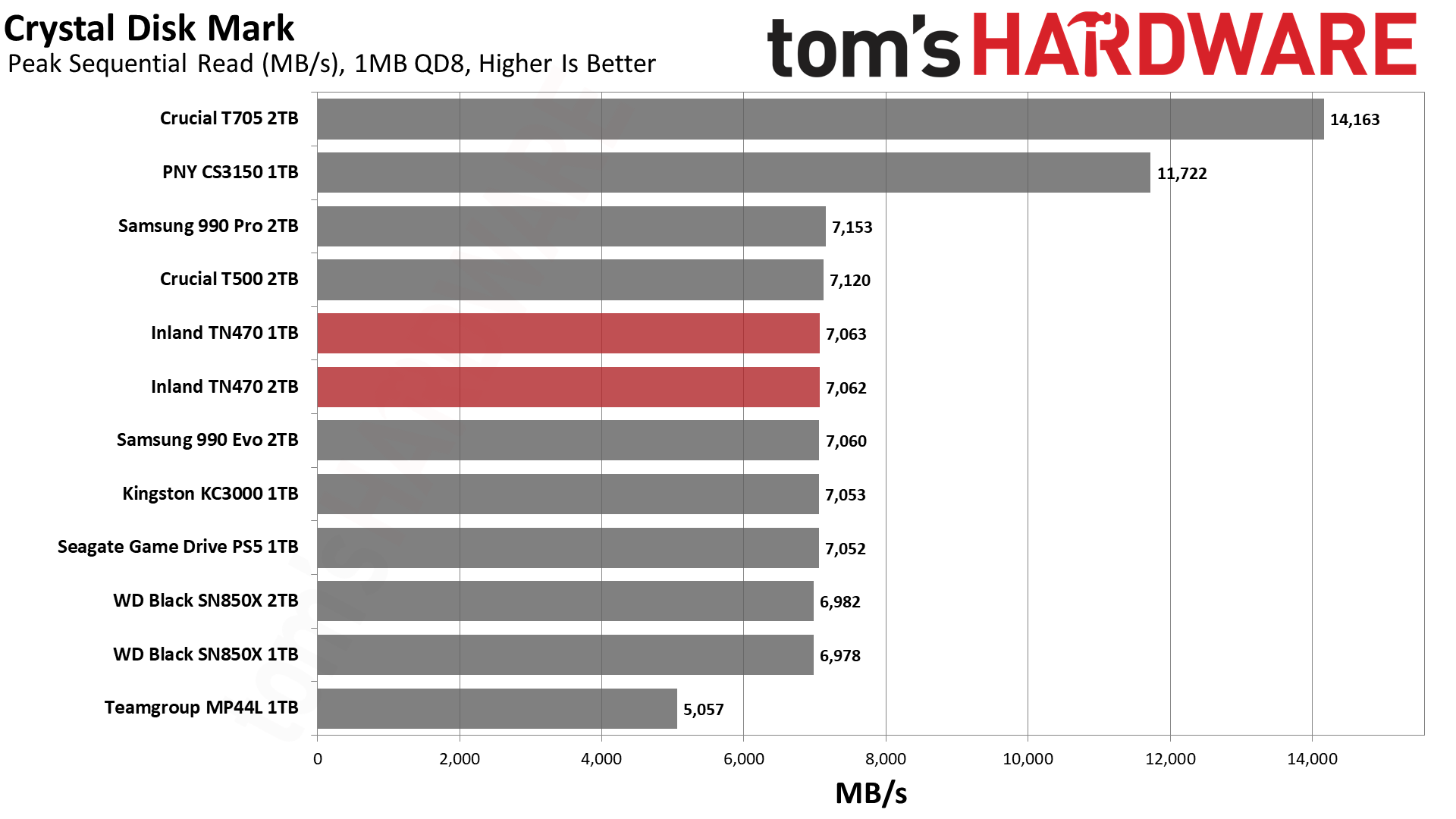


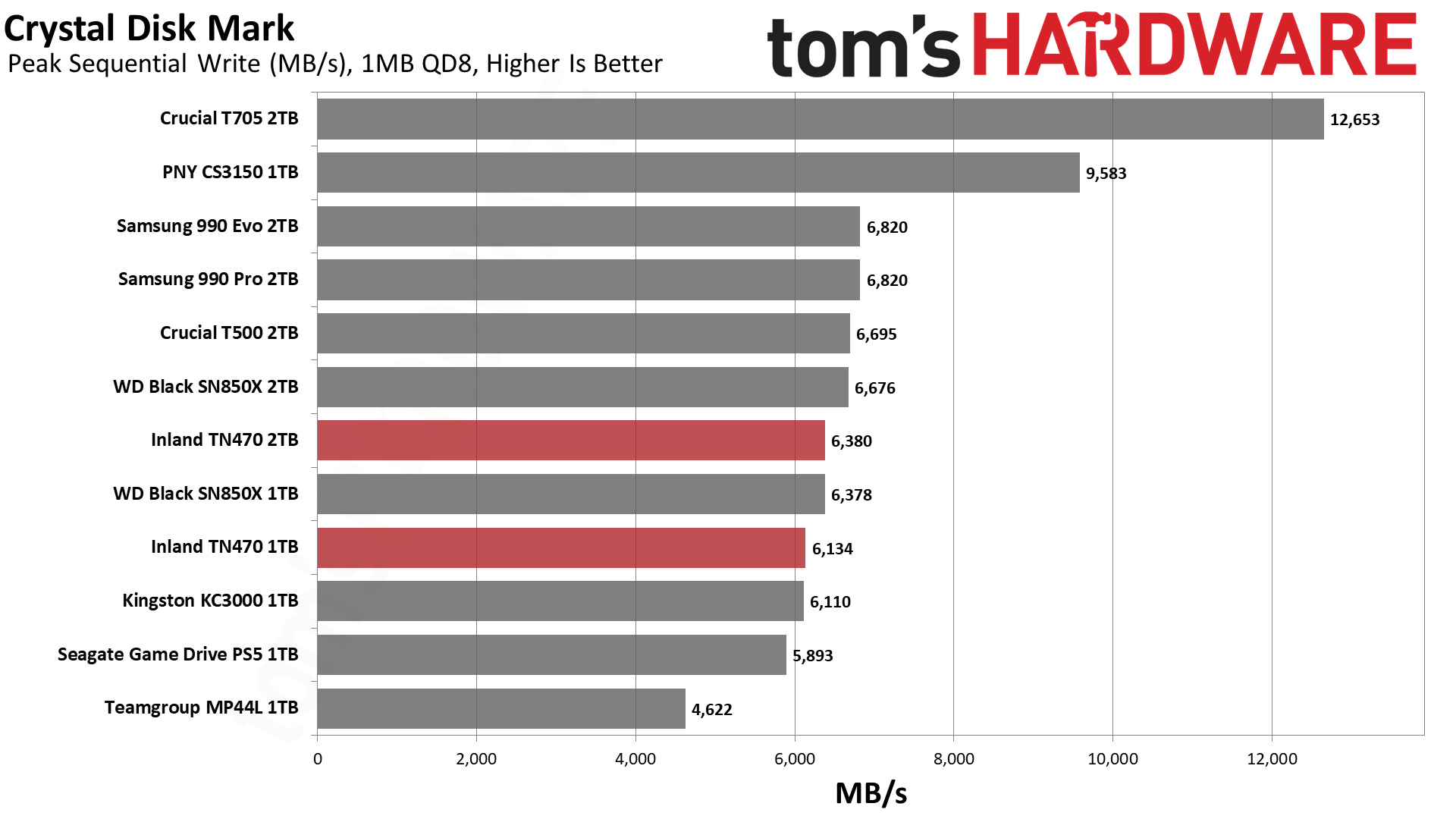

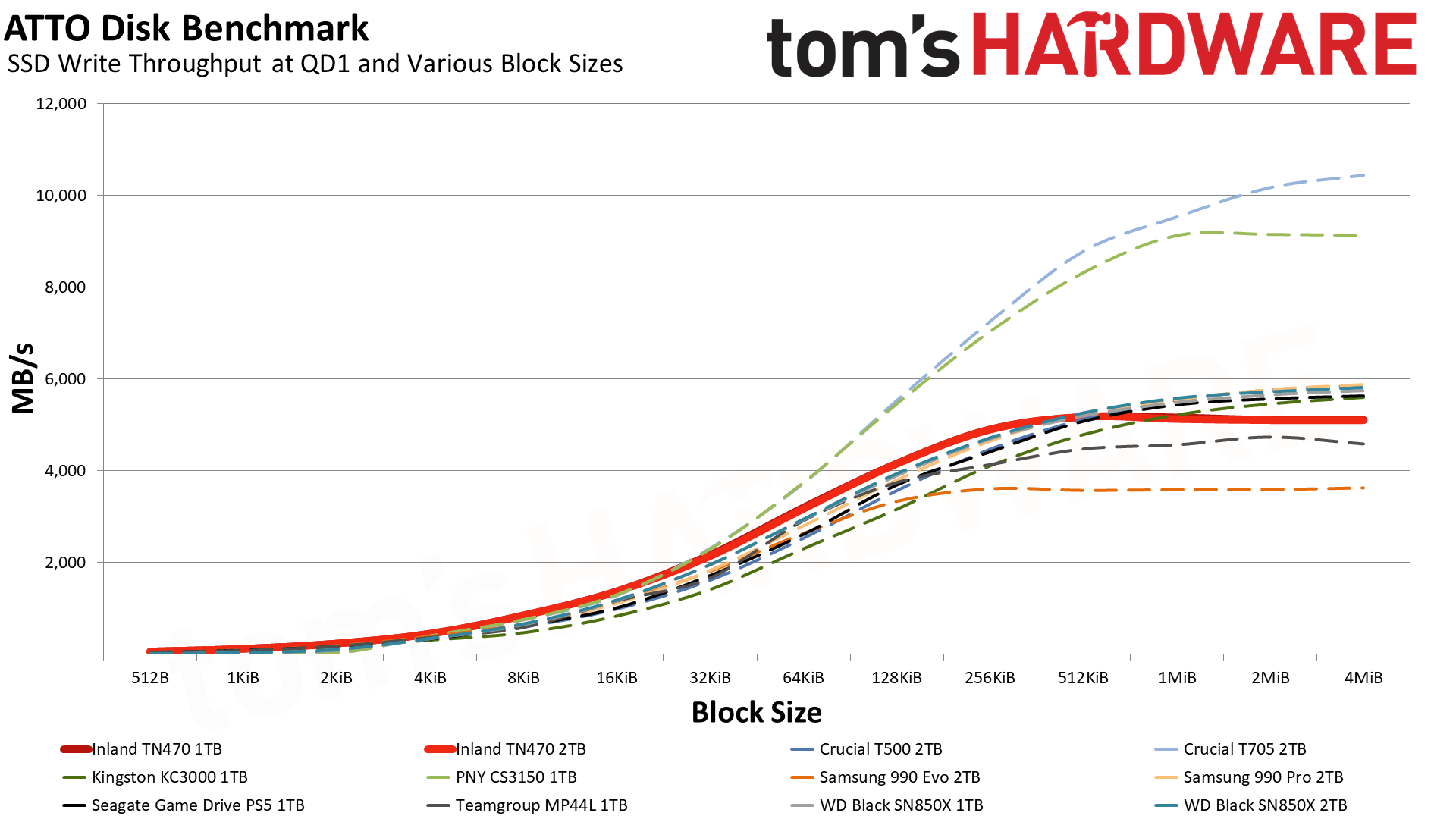
We have zero complaints about the TN470’s performance in ATTO. Phison is often optimized pretty well here for reads especially. We do see a plateau effect with writes, and there are many possible reasons for this. One is that we are at the limits of what this controller can put out, versus one that could interleave to eight channels or optimize with DRAM. Another is that the flash being used, Kioxia BiCS6, has this performance profile, with a leveling off starting at 512KiB.
This drive uses 1Tb dies and has a chip enable (CE) for each die, regardless of capacity, which gives stronger interleaving at 2TB but reaches a cap in ATTO once you read two dies per channel at 1TB. As this is quad-plane flash, a superpage here will be 512KiB in size, so that’s a reasonable peak for writes. Reads have more headroom for larger I/O.
This is reflected in CDM’s sequential results, where reads have a more significant improvement with higher queue depth in comparison to writes. Of the two, sequential reads can give a better impression of loading times, as sequential reads are not uncommon for games and applications. Here, the TN470 isn’t quite as robust as most other drives on the list, but it's fast enough.
Looking at random performance, we see that random read latency, which everyone focuses on for 4KB random read performance, is pretty good. The TN470 is a snappy drive, especially as random write latency is fantastic.
Sustained Write Performance and Cache Recovery
Official write specifications are only part of the performance picture. Most SSDs implement a write cache, which is a fast area of (usually) pseudo-SLC programmed flash that absorbs incoming data. Sustained write speeds can suffer tremendously once the workload spills outside of the cache and into the "native" TLC or QLC flash.
We use Iometer to hammer the SSD with sequential writes for over 15 minutes to measure both the size of the write cache and performance after the cache is saturated. We also monitor cache recovery via multiple idle rounds. This process shows the performance of the drive in various states as well as the steady state write performance.

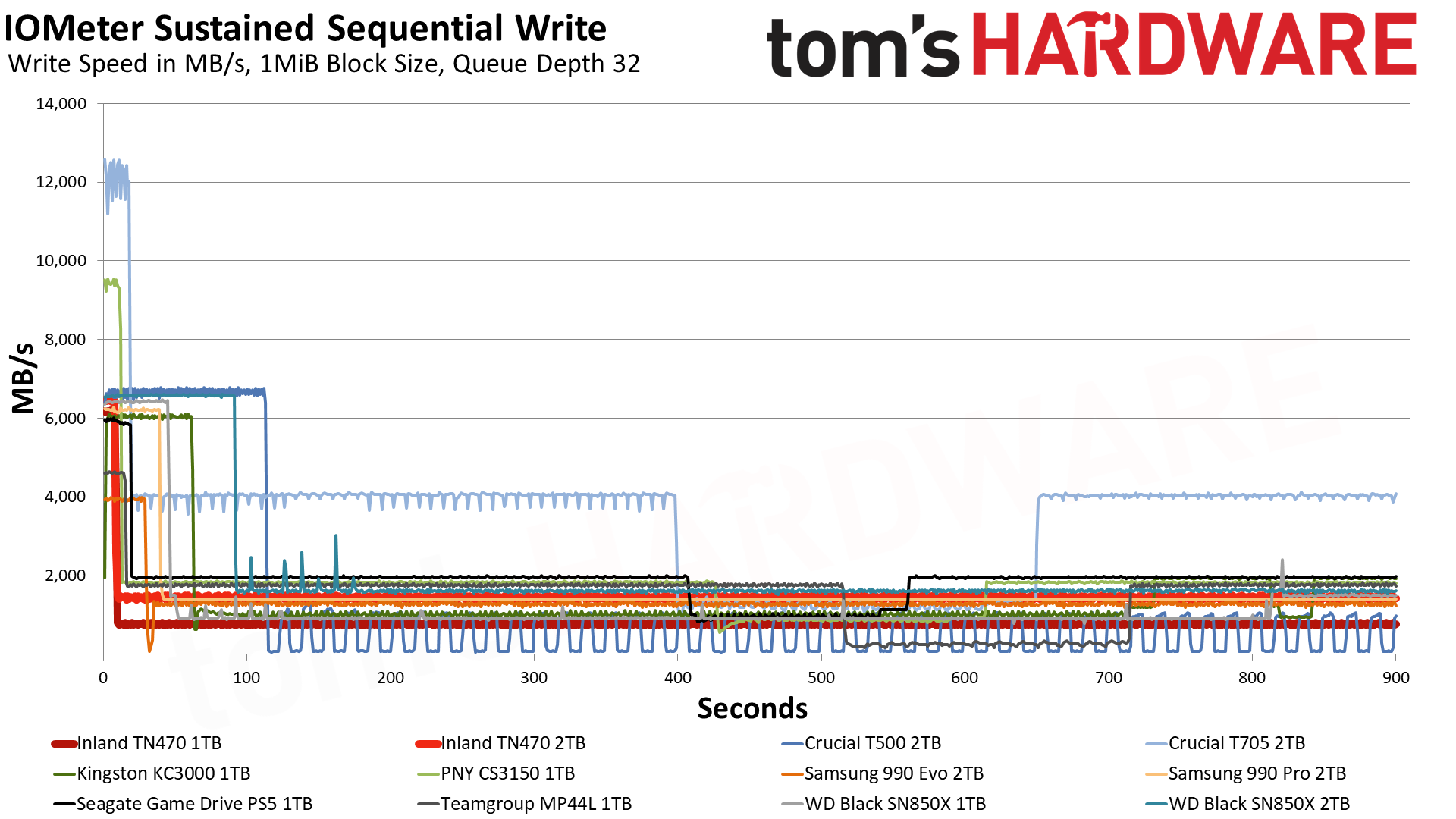
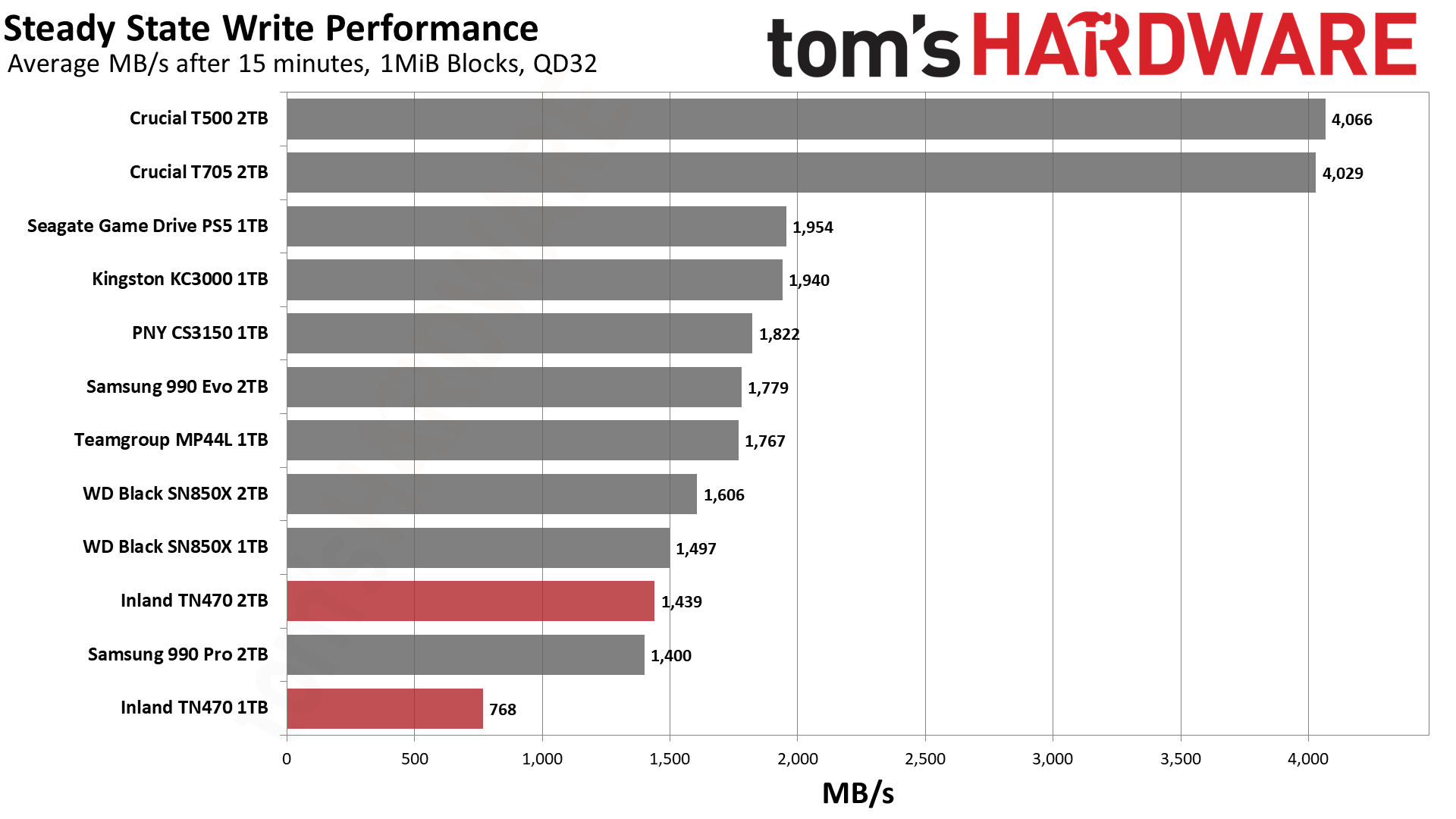
Both the 1TB and 2TB TN470 write for over 8 seconds in pSLC mode, at 6.16 and 6.44 GB/s respectively. The 2TB can hit a higher speed thanks to its extra interleaving. The cache in both cases is about 50GB or so. This is small, but it means the cache is larger relative to the TLC flash on the 1TB model. The advantage of a small cache is that it maintains its size better with drive use and post-cache performance can be more consistent.
In this case, the two drives write at about 800 MB/s and 1.4 GB/s in TLC mode, which is not a bad result for a budget drive. We’ve seen higher with other flash — take the MP44L using Micron’s 176-Layer TLC, for instance — but at 2TB this is plenty fast. At 1TB we are less enthused.
Power Consumption and Temperature
We use the Quarch HD Programmable Power Module to gain a deeper understanding of power characteristics. Idle power consumption is an important aspect to consider, especially if you're looking for a laptop upgrade as even the best ultrabooks can have mediocre stock storage. Desktops may be more performance-oriented with less support for power-saving features, so we show the worst-case.
Some SSDs can consume watts of power at idle while better-suited ones sip just milliwatts. Average workload power consumption and max consumption are two other aspects of power consumption but performance-per-watt, or efficiency, is more important. A drive might consume more power during any given workload, but accomplishing a task faster allows the drive to drop into an idle state more quickly, ultimately saving energy.
For temperature recording we currently poll the drive’s primary composite sensor during testing with a 21-22°C ambient. Our testing is rigorous enough to heat the drive to a realistic ceiling temperature.
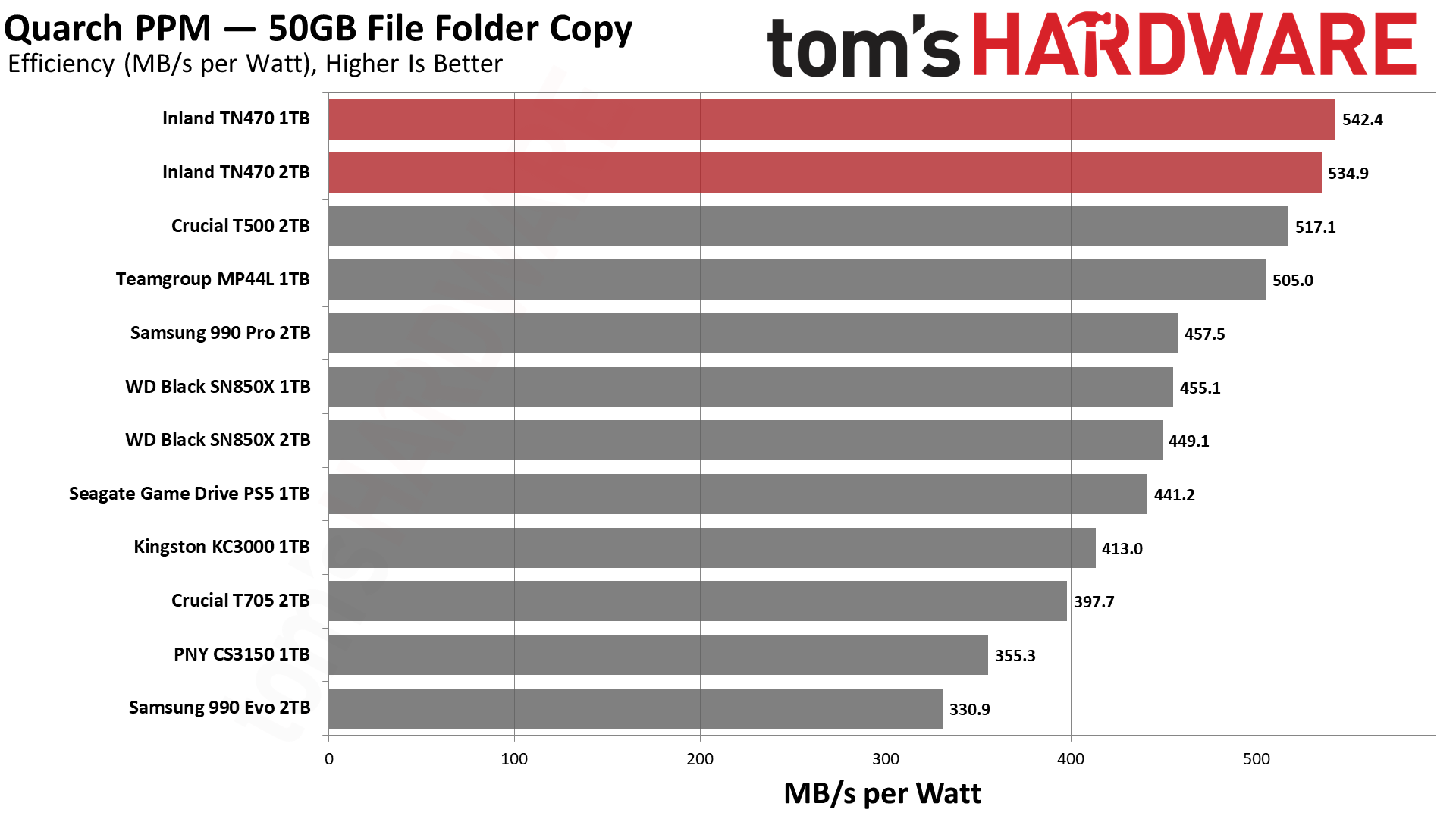
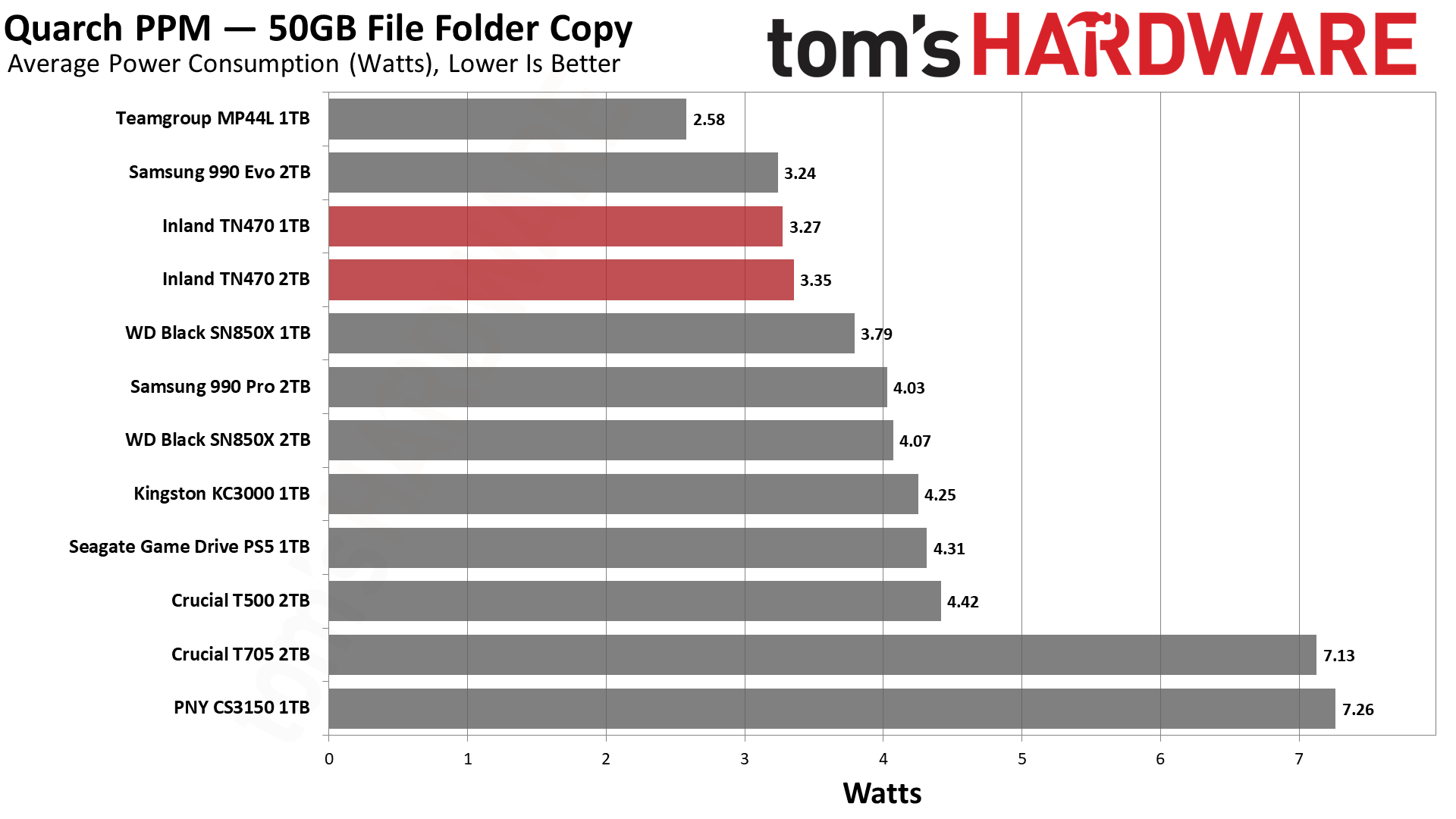
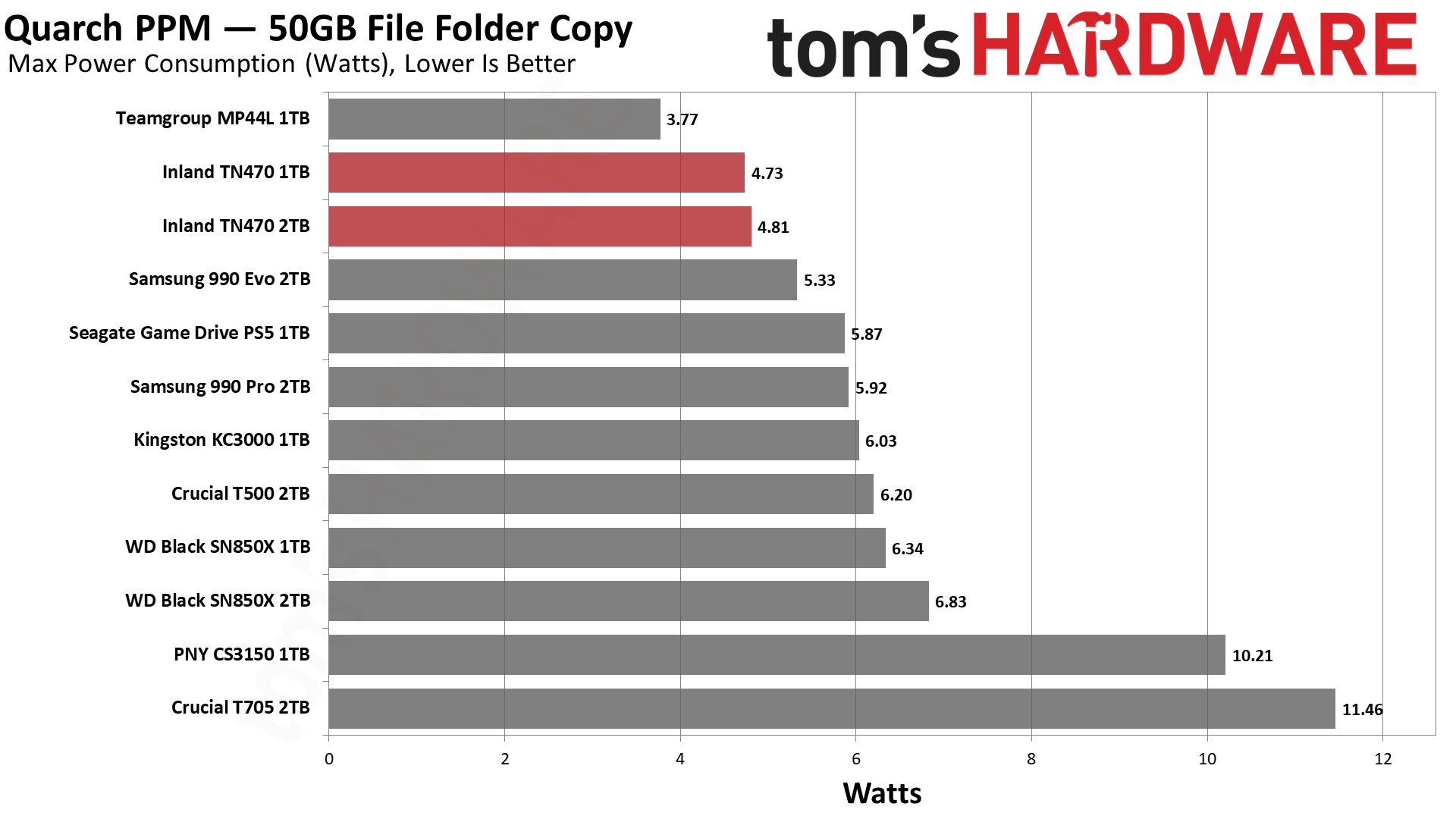
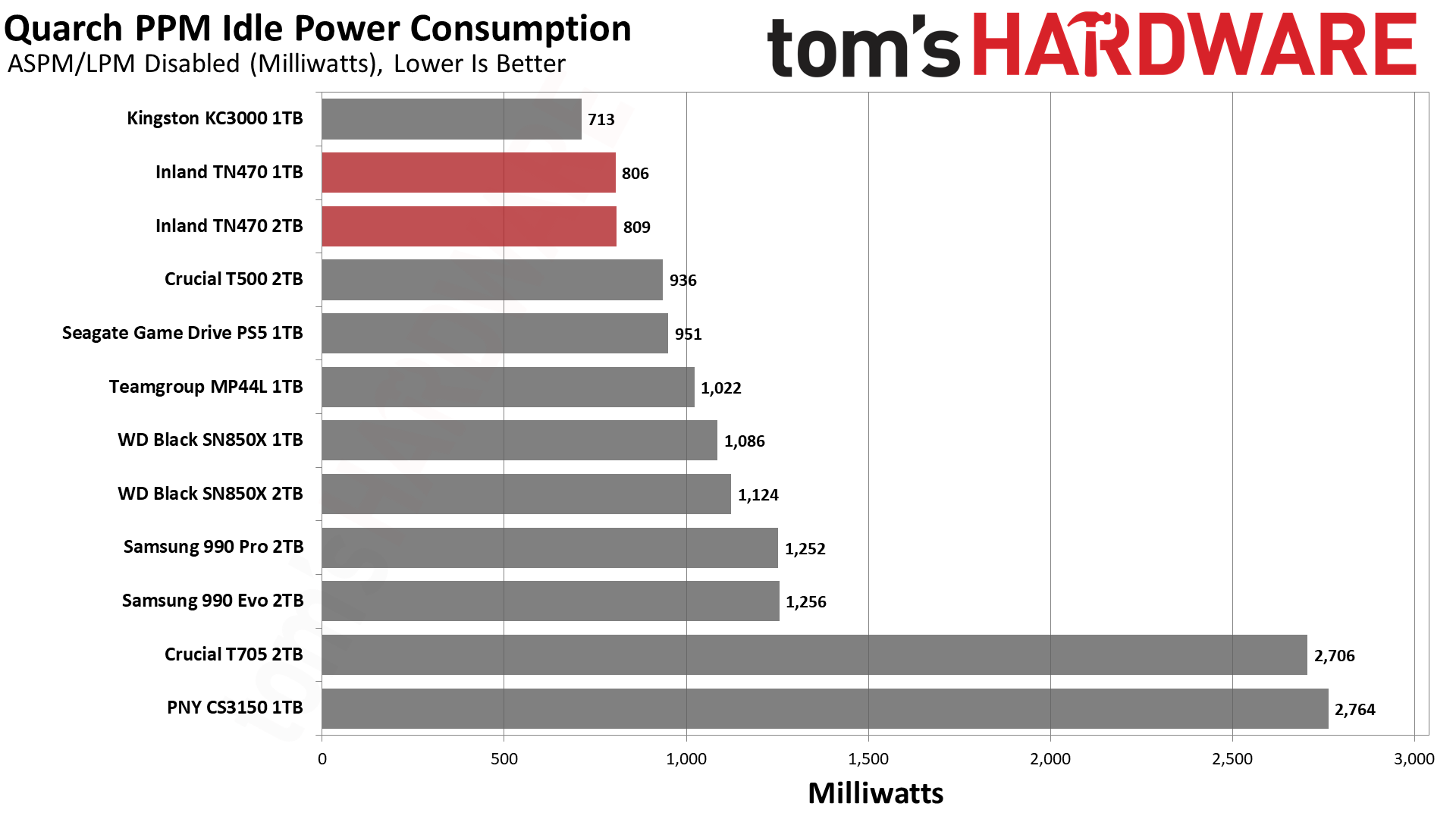
The TN470 is exceptionally efficient, better than any of the other drives tested today. This makes it an excellent choice for laptops in particular, though it's also good in desktops. The combination of the faster E27T controller and BiCS6 flash go well together. BiCS has a history of not being super efficient with licensed controllers, but BiCS6 uses circuit under array (CuA) technology that can bring solid power consumption improvements. It’s not as efficient as YMTC’s 232-Layer flash, which uses wafer-on-wafer technology at a higher layer count, but Kioxia has plans for its own CMOS bonding (CBA) in the future.
Neither the 1TB nor the 2TB TN470 got anywhere near throttling in our setup. In fact, there was up to 30°C of clearance for the 2TB, which did run the hotter of the two. Additional interleaving and performance will cause the drive to produce more heat. However, in both cases, these drives proved that they would be excellent for use in any system even without additional cooling.
Test Bench and Testing Notes
| CPU | Intel Core i9-12900K |
| Motherboard | Asus ROG Maximus Z790 Hero |
| Memory | 2x16GB G.Skill DDR5-5600 CL28 |
| Graphics | Intel Iris Xe UHD Graphics 770 |
| CPU Cooling | Enermax Aquafusion 240 |
| Case | Cooler Master TD500 Mesh V2 |
| Power Supply | Cooler Master V850 i Gold |
| OS Storage | Sabrent Rocket 4 Plus 2TB |
| Operating System | Windows 11 Pro |
We use an Alder Lake platform with most background applications such as indexing, Windows updates, and anti-virus disabled in the OS to reduce run-to-run variability. Each SSD is prefilled to 50% capacity and tested as a secondary device. Unless noted, we use active cooling for all SSDs.
Inland TN470 Bottom Line
Is the Inland TN470 an excellent budget drive? Yes. It checks all the right boxes with good all-around performance and high power efficiency. Its single-sided design is also great for laptops.
If there were to be a big caveat, it’d be on price, since this market segment — with drives that can max out the PCIe 4.0 interface — is getting pretty crowded. However, the TN470 is priced reasonably well, too. That makes it difficult to find any downsides, but capacity is unfortunately a significant one. At 1TB this drive isn’t quite as good as the competition, and there’s no 4TB option as you have on many competing drives.
This means that at 1TB you have better alternatives like the T500 and older eight-channel drives like the KC3000, all of which have DRAM. For DRAM-less, you could duck down to the MP44L or WD Black SN770, and those are viable if you need to save every penny. However, the TN470 can be found at a similar price, so it’s becoming harder to recommend the midrange budget PCIe 4.0 SSDs. That means the 1TB TN470 can still make sense for laptops where you might not want a hotter-running eight-channel solution from yesteryear. That said, we think that it’s not the best choice for the PS5.
At 4TB there are an array of excellent options including the Lexar NM790 and Addlink A93. Will we see 4TB later for the TN470? Possibly — Phison plans on offering that capacity with this controller. Crucial also plans on 4TB with its DRAM-equipped T500. If you want 4TB for your laptop right now, or for a secondary desktop SSD, then this leaves the TN470 out in the cold for now.
That leaves the 2TB model, which has become the sweet spot for SSDs, and at that capacity the TN470 is an excellent all-around drive. It's an easy go-to if you are making a new build and don’t want to fuss around, and it’s also great for laptops. If you want a drive you can pick up and install affordably without having to worry about min-maxing, you can rest assured that the TN470 will work well without the hassle of research or second guessing. It's not the absolute fastest PCIe 4.0 drive around, but it's a great value and doesn't give up much in the way of performance.
MORE: Best SSDs
MORE: Best Hard Drive
MORE: Best SSD for the Steam Deck

Shane Downing is a Freelance Reviewer for Tom’s Hardware US, covering consumer storage hardware.
-
phillipnolan amazing turn around? https://www.tomshardware.com/reviews/inland-performance-ssd-review-the-low-performance-nicheReply -
Rokinamerica Reply
You realize you linked to a different drive, right?phillipnolan said:amazing turn around? https://www.tomshardware.com/reviews/inland-performance-ssd-review-the-low-performance-niche -
ohio_buckeye Been using inland products at times for a while and no major complaints. My wife’s desktop has a 480gb sata ssd from inland in it that’s probably at least 3-4 years old. No issues with it.Reply -
HaninTH A set of 4 x 2TB of these in a ZFS pool for VM Guest hosting? Might be a fun experiment!Reply -
Avro Arrow This seems weird to me. According to Inland's specifications, this thing rivals the far more expensive WD BLACK SN850X.Reply
Micro Center's marketing team is asleep at the wheel. If I was in charge, this SSD wouldn't be called the TN470, it would be called "Taipan" as in, "Inland Taipan".
-
Amdlova If you have a spare pcix 4 or a 22110 slot have some enterprise ssds around new. Got one toshiba xd5 1.92 tb for 85us on ebay new...Reply
You can waste it 3650tb of writes... you will die but this drive will remain -
johnxmiles ReplyTom's Hardware Verdict
The Inland TN470 is a solid all-around PCIe 4.0 SSD that would be right at home in a laptop, desktop, or PS5. We prefer the 2TB capacity, but even with considerable competition, the current pricing and availability make it a good option.
$79.99 at Amazon is CLICK BAIT& SWITCH as at this point, only 2TB has been mentioned and this price is for only an 1TB. A direct click to the 2TB site would have shown a $136.99 price which is a good deal. So why should I trust Tom Hardware when it uses ClickBait & Switch tricks? I know that “selling your soul” is a common practice these days but hold off to find a buyer worthy of your soul.
